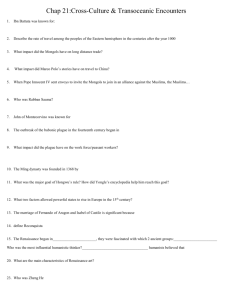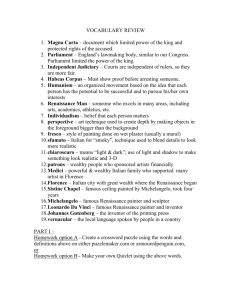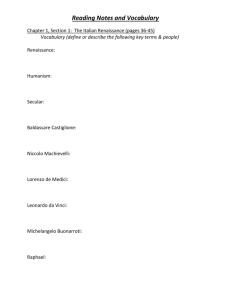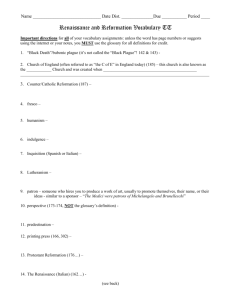The Renaissance - Mr. McKinley's classroom
advertisement
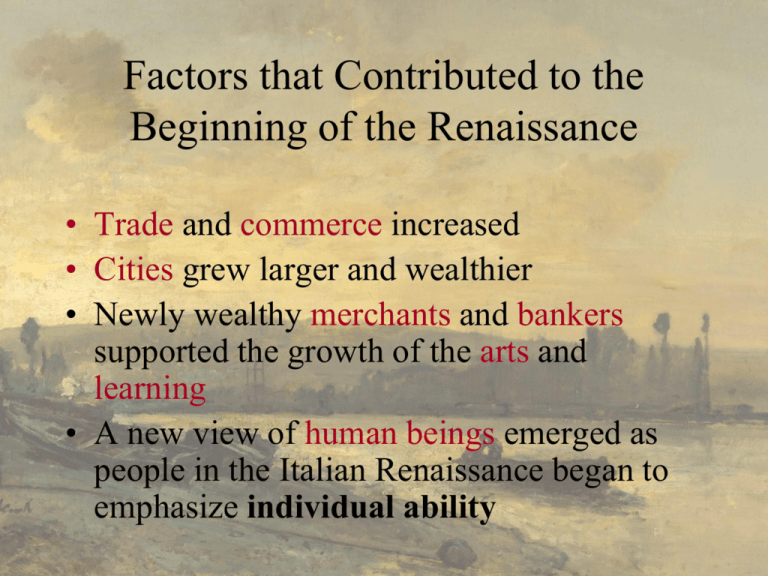
Factors that Contributed to the Beginning of the Renaissance • Trade and commerce increased • Cities grew larger and wealthier • Newly wealthy merchants and bankers supported the growth of the arts and learning • A new view of human beings emerged as people in the Italian Renaissance began to emphasize individual ability BEFORE and AFTER Compare and Contrast artwork… What was the Renaissance? The Renaissance was a cultural movement and a time of renewal (Europe was recovering from the Dark Ages and the Black Death/Bubonic Plague) Renaissance means “rebirth” of classical knowledge and “birth” of the modern world (new intellectual and artistic ideas that developed during the Renaissance marked the beginning of the modern world) Where did the Renaissance begin? •Italy •Italian Cities •Urban Societies •Major Trading Centers •Secular Movement •People lost their faith in the church and began to put more focus on human beings and material possessions When did the Renaissance Take Place? Roughly the 14th to the 17th century April 6, 1341: Francesco Petrarch is Crowned Poet Laureate Many historians cite this date as the beginning of the Renaissance. 1429: Cosimo de Medici Takes Over his Father's Business Cosimo de Medici becomes head of the bank after his father dies, using his economic power to consolidate political power. Within five years he runs the city without question. 1600-1620s: William Shakespeare happens William Shakespeare writes like a million plays and sonnets…give or take a few. How did the Crusades contribute to the Renaissance? Crusades (1095 – 1291) = Religiously sanctioned military campaigns waged by Roman Catholics against Muslims who had occupied the near east (after Muhammad’s death in 632, the Rashidun Caliphate was one of the largest empires of the time period) Increased demand for Middle Eastern products Increased production of goods to trade in Middle Eastern markets The Black Death: Bubonic Plague • 1330s - An outbreak of deadly bubonic plague occurred in China • Mainly affects rodents, but fleas can transmit the disease to people • Once people are infected, they infect others very rapidly • Plague causes fever, painful swelling of the lymph glands, and spots on the skin that are red at first and then turn black = Black Death • Since China was one of the busiest of the world's trading nations, it was only a matter of time before the outbreak of plague in China spread to western Asia and Europe • In 1347, Italian merchant ships returned from a trip to the Black Sea, one of the key links in trade with China. When the ships docked in Sicily (Italy), many of those on board were already dying of plague. • Within days the disease spread to the city and the surrounding countryside Bubonic Plague Continued • After five years 25 million people were dead--one-third of Europe's population. • Smaller outbreaks continued, not just for years, but for centuries. The survivors lived in constant fear of the plague's return, and the disease did not disappear until the 1600s. • People began to look for who to blame. (Lepers or Jews) • The disease took its toll on the church as well. Many Christians had prayed devoutly for deliverance from the plague. Why hadn't those prayers been answered? A new period of political turmoil and philosophical questioning lay ahead. Political Ideas of the Renaissance Niccolò Machiavelli (1469-1527) An Italian Philosopher and Writer based in Florence during the Renaissance The Prince (Published in 1532) Machiavelli believed: “One can make this generalization about men: they are ungrateful, fickle, liars, and deceivers, they shun danger and are greedy for profit” Machiavelli observed city-state rulers of his day and produced guidelines for how to gain and maintain power. Absolute Rule He felt that a ruler should be willing to do anything to maintain control without worrying about conscience. • Better for a ruler to be feared than to be loved • Ruler should be quick and decisive in decision making • Ruler keeps power by any means necessary • The end justifies the means • Be good when possible, and evil when necessary Today, the term “Machiavellian” refers to the use of deceit in politics Italian City-States Because Italy failed to become united during the Dark Ages, many independent city-states emerged in Italy. Each city-state was controlled by a powerful family and dominated by a wealthy merchant class. Their interest in art and emphasis on personal achievement helped to shape the Italian Renaissance. Example: The Medici family of Florence ranked among the richest merchants and bankers in Europe; they ruled Florence for over 70 years. Major Italian City-States Milan One of the richest cities, it controls trade through the Alps. Venice Located on the Adriatic Sea, it is a major trade route between Asia & Europe. Florence Controlled by the Medici Family, who became great patrons of the arts. Milan Venice Genoa Florence Genoa Had Access to Trade Routes Rome Headquarters of the Catholic Church All of these cities: • Had access to trade routes connecting Europe with Middle Eastern markets • Served as trading centers for the distribution of goods to northern Europe Rome Centralized Power One governing authority (ex. U.S. Federal Government; principals) controls power over several smaller entities (ex. State governments; teachers) 28.3 The Growth of Trade and Commerce The Renaissance produced new ideas that were reflected in the arts, philosophy, and literature. Patrons, wealthy from newly expanded trade, sponsored works which glorified city-states in northern Italy. Education became increasingly secular. Types of Renaissance Art Classical art showed the importance of people and leaders, as well as gods and goddesses Medieval art and literature focused on the Church and salvation Renaissance art and literature focused on the importance of people and nature, along with religion
